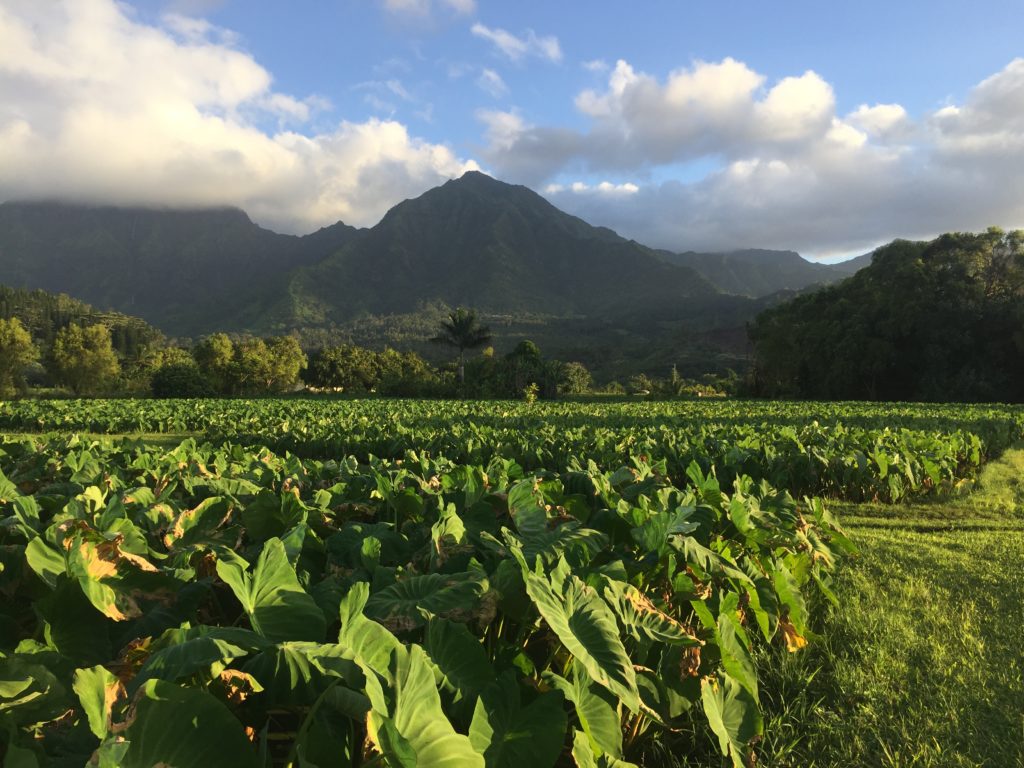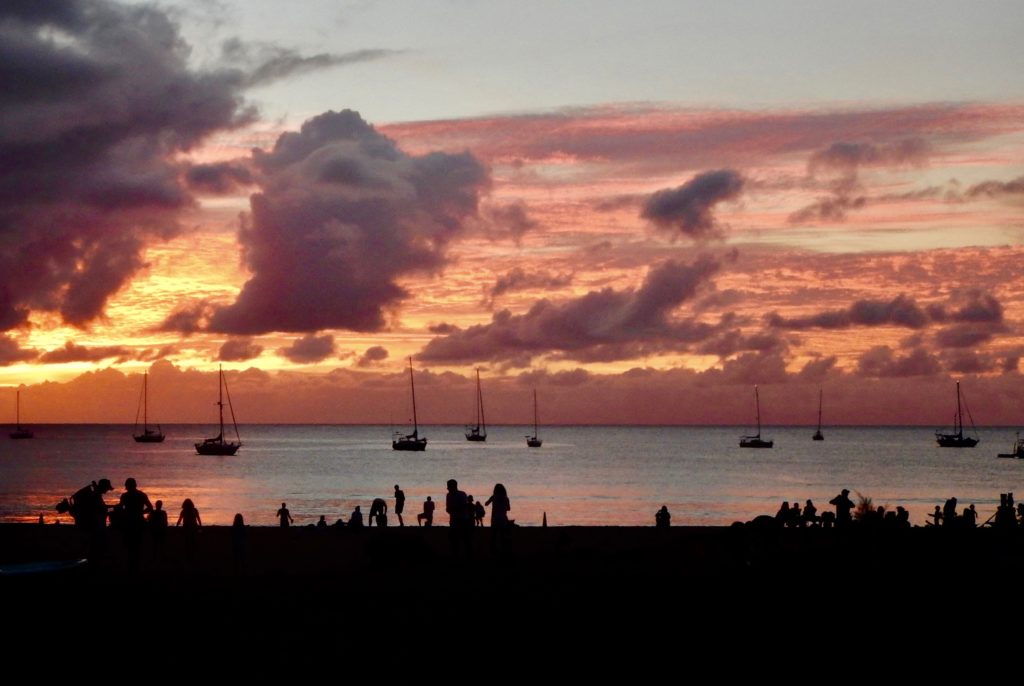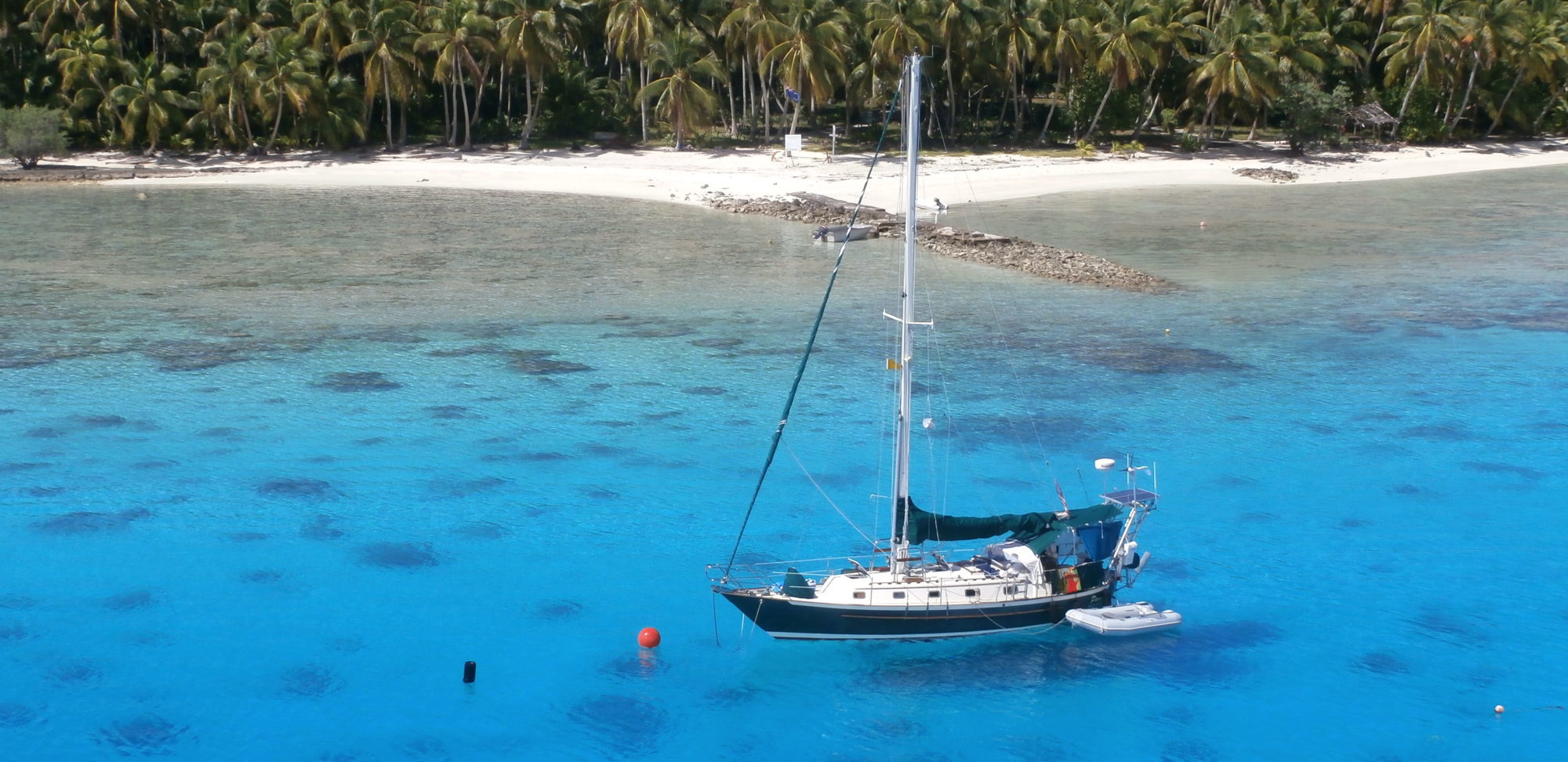Sail with me to the barefoot soul of Kauai.
I needed a good reason to take sailing vessel Pamela back out to sea after a two-year hiatus. I’d sailed her all the way to New Zealand and back, yet still I was dragging. Something about sailing back out the Golden Gate seemed ominous. Watching the insidious lines of fog reaching along the coast made me want to wrap up in layers of wool.
Adrift and bereft, unsure of what I was to do next, sailboat-wise, with a voice in my head asking will I ever make another long-distance voyage on my own boat? Like so many other yachtsmen, I found myself tied to the dock in my home port and unable to move. Take a stroll down any marina wharf and you’ll see what I mean: hundreds of beautifully gleaming sailboats that never leave the slip.
A different voice in my head answered: you’re turning 60, you old coot, perhaps you’d better get out there while you still can.
Why not sail to Hawaii for the summer? It takes three weeks to get there and four to return, so you might as well set your anchor and stay there a couple of months, then split before the hurricanes begin to form. Sailing there is a sweet treat, all downwind. And hanging out like a local beach bum would be a kick. But I would have to psych myself up for the long, bumpy trip back to San Francisco. I could do it solo. I would turn 60 in August. The notion of 60 and solo could be reason enough to do it.
On the island of Kauai there was a major flood in April, the worst in living memory. Bridges were washed out, roads were closed. People were living under tarps. Maybe I could join the relief effort there.
And the Singlehanded Transpacific Yacht Race would be happening, a solo race from San Francisco straight to Hanalei Bay on the far northwestern edge of Kauai. Solo sailors on fast boats would be splashing into the bay sometime in early July. Maybe I could hang out with them.
So without a good reason, but with a fistful of reasons all reasonable, my plan for sailing to Hanalei began to form: sail there in May, lie at anchor for a couple of months, then sail home.
But what would I do all summer just hanging out in Hanalei?
Just hanging out in Hanalei … mmmm.
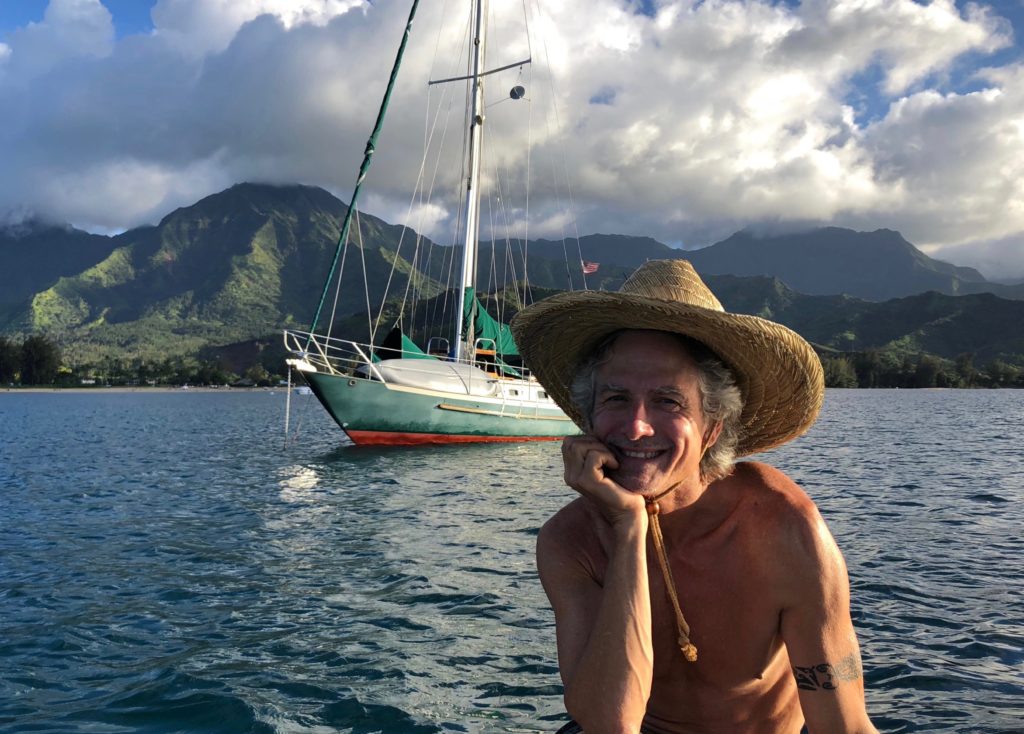
Now when my son Lindsay heard I was sailing to Hawaii he signed on immediately as crew. He and I have crossed oceans together and we get on well at sea. Apart from his watches he sleeps for hours, sometimes days, wakes up hungry and hollers “Feed!” He’s a growing boy and I suppose my galley cookin’ suits him just so.
Then a week later, while cycling through Monterey with a my old buddy Milo, he announced that he was coming too! The day was warm, the ocean looked like Walden Pond, and a light sea breeze beckoned. I couldn’t tell if he was serious. Now, Milo is a landsman. In a good way, of course. He golfs four times a week, his cleats planted firmly. He is a horse racing fanatic, and the sound of thundering hooves further roots him to the land. My tales of sea sickness, long hours of abject boredom, and midnight squalls with flying squid hitting you square in the face would not shake Milo from his intentions. He was sincere and intent on the notion. The crew of Pamela was multiplying faster than fleas on Noah’s ark.
Three is actually a good number for a crew to Hawaii. The watch schedule would be “two hours on, four hours off,” right ‘round the clock. If anyone starts to get on your nerves simply alter the schedule such that you never have to experience them awake.
At this point my simple plan for sailing like a misty-eyed contemplative mystic to Hanalei needed an overhaul. I would sail solo on the homeward voyage at the end of the summer, but for the outward leg I would need to provision for a crew of three and prepare my crew for the three-week journey. This would take more than just eating extra-crunchy peanut butter out of the jar with my fingers. I’d need a provisioning plan to keep three people alive for up to five weeks whilst avoiding an outbreak of scurvy.
You can actually get scurvy on land. In fact, I know a student at Stanford University who ate only ramen for a month and got scurvy. I don’t know whether he graduated.
When provisioning for a long passage at sea, start with Provisioning Rule #1: Never take anything you actually don’t like to eat. This is not obvious! Plenty of world-class long-distance sailors return from voyages carrying loads of uneaten, unopened processed food. Lazarettes full of rice and ramen, crates of Dinty Moore beef stew, and pallets of energy bars.
One-pot meals are the easiest dinners at sea, and you can stuff these with your fresh vegetables before they spoil. My half-size pressure cooker is the secret to scrumptious and savory one-pot meals. I leave the pot on the stove until it’s all eaten up, then start the next one a couple of days later. Even the most vile of one-pot meals will transcend before your eyes into a gastronomic delight if you throw in a can of coconut milk, like when a princess kisses a toad.
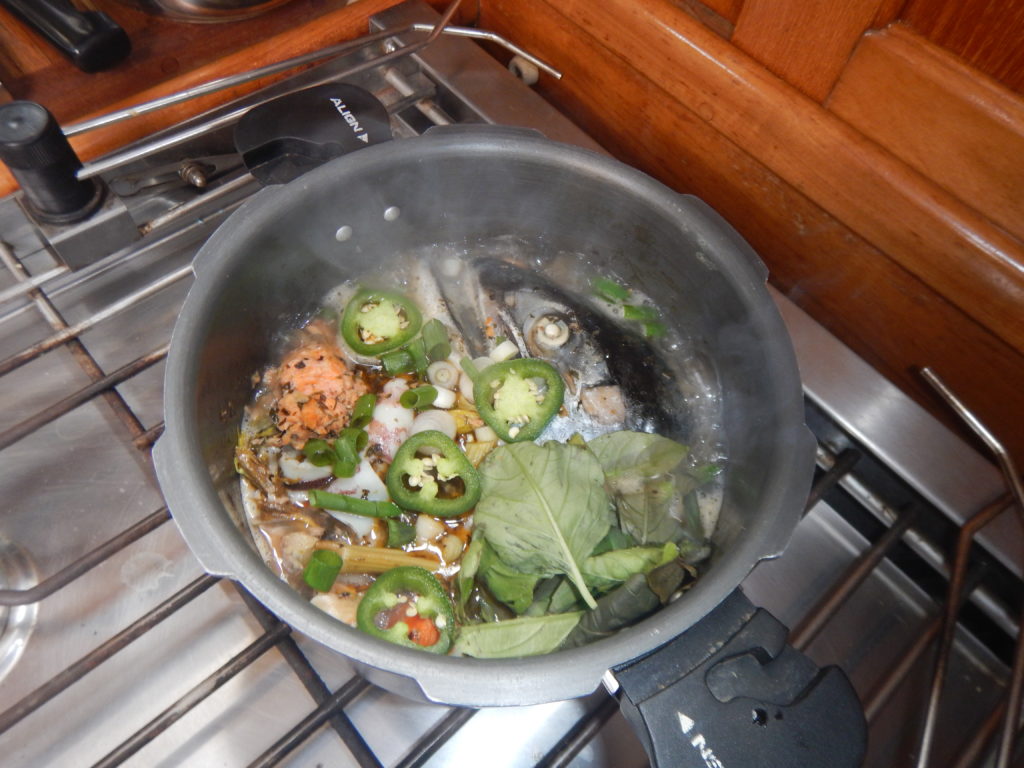
Next came the shakedown. Pamela had not been to sea in two years so I would have to nudge her down the coast for a ways to see what might be broken. We would sail down to Monterey, perhaps tuck in at Half Moon Bay if necessary. I was worried about the watermaker, concerned about the Monitor wind vane, curious about my new refrigeration system, and apprehensive about my SSB radio. Lindsay and I left Redwood City on a strong ebb tide that pulled us up the bay to Aquatic Cove. There we set our anchor and watched the crescent moon rising over the San Francisco cityscape.
You might be familiar with San Francisco’s Hyde Street Pier and its preserved tall ships and nautical museum. I sometimes come here the first Saturday of the month to sing sea chanteys on the 1890 steam ferryboat Eureka. This place connects me with the people of a bygone era. There’s a wonderful little anchorage in Aquatic Cove by the pier, and you can anchor with the National Park’s permission and enjoy a special evening on San Francisco’s infamous Barbary Coast.
We mustered at 02:00 to catch the next ebb tide out through the Golden Gate. The tide was strong and we timed it perfectly. Even five miles beyond the Gate that ebb was still pushing us out. Next stop, Monterey.
Now the Kentucky Derby happened to be running and Milo was throwing a big party in Monterey. Mint juleps and Kentucky Bourbon flowed in copious measure. We cheered and hollered at the horses until we were all hoarse. The next day at 13:00 we recovered sufficiently to load our final provisions aboard Pamela. It was all smiles on the dock. Then we cast off our lines and squeezed through the breakwater bound for Hanalei Bay.
Two miles out we were getting a shellacking. I’d underestimated the power of the swells as they churn with unfettered fetch into Monterey Bay. The wind gusted to force 6 on the nose as we clawed away from the coast. We were jostled sufficiently to summon the gods of the sea and we prayed that the swells, and our stomachs, would settle down.
Welcome to the ocean. It’s going to be like this a while.
People taking their first offshore voyage from California are often surprised by how rough these coastal waters are. The swells from the cold north Pacific roll uninterrupted for thousands of miles and those lines of kinetic energy seem never to dissipate as they hold their course, each pushed by another from behind. When a swell reaches the continental shelf it piles up in confusion and turns back seaward in a drama of suicide. The first day was miserable. We each got sick in turn. “What happens on the ship stays on the ship.” Until the waves wash it all off.
We began to get our sea legs and appetites returned in a couple days. Lindsay wanted bacon and we had 144 pre-cooked slices onboard, courtesy of a sympathetic aunt who’d sent us two giant packs via FedEx. Milo’s stomach was adjusting to life at sea and he was happy with raw vegetables and fruit juice. I served one-pot meals with coconut milk and made stove-top bread in my heavy iron skillet. When the yeast wouldn’t rise I smeared tomato paste on one cooked side, then topped it with cheese and bacon and called it pizza.
A few days later we hit a light-wind snag. The weather charts showed five days of near-zero wind. Four knots of wind, max. This can be incredibly nerve-wracking. I gathered my crew and gave a short at-sea pep talk. “Men,” I began, then paused for emphasis; “we will be confronting a five-day calm. We will run our engine at night and drift by day.” I imagined everyone losing his cool and going berserk after a day of dead calm, starting with me.
Yet the wind defied the dismal forecast and rose just enough to push Pamela along at about four knots. The old girl can do quite well in seven knots of wind if the seas are not too rough, coasting along at four knots. For a week we moved along at low speed. Life at sea became quite tranquil. Then we met the freighter.
Milo and I were spinning yarns in the cockpit one afternoon, lazily checking the horizon now and then, enjoying the fine, settled weather. He glanced up quickly and pointed. “Is that a ship?”
I had to crane my neck around the awning to see what he was looking at. And there it was, a mile away, all ugly dull green, steaming at twenty knots straight across our path, throwing a bow wave across a wall of rivets.
Instantly we changed Pamela’s direction and hove-to, then hailed the freighter’s captain by radio. “Argo, Argo, this is sailing vessel Pamela. We are hove-to off your starboard bow. How copy?” There was no response.
“Milo! Quick, get the GoPro!” This was going to make a stunning hair-raising clip if we didn’t get smashed.
After a couple of hails the captain of the freighter returned our call. A sleepy voice came over the VHF: “OK.” And the freighter continued on its way to the orient.
A very near miss, the closest I’ve been to a freighter at sea. Milo was a little wild-eyed for the rest of the day.
The calm spell had driven us far to the south and the nor’east trades kicked in with a vengeance. Now we were surfing down waves and gybing downwind. Each morning I crept to Pamela’s bow and fixed my feet in position, just so, one anchored to a bronze cleat and the other snug against a stanchion, while my hands held fast to the staysail stay and pulpit rail. From this vantage point I could see the big swells pushing Pamela’s canoe stern down the face of each wave. She was literally surfing, and I on her bow surfing as well. A brand new sport! Bow surfing. It was a rollicking finish and our excitement rose as we sailed into Hawaiian waters.
And one morning the rain clouds parted just enough to reveal the sharp features of the Anahola mountains. Land ho! Twenty and three-quarter days from Monterey.
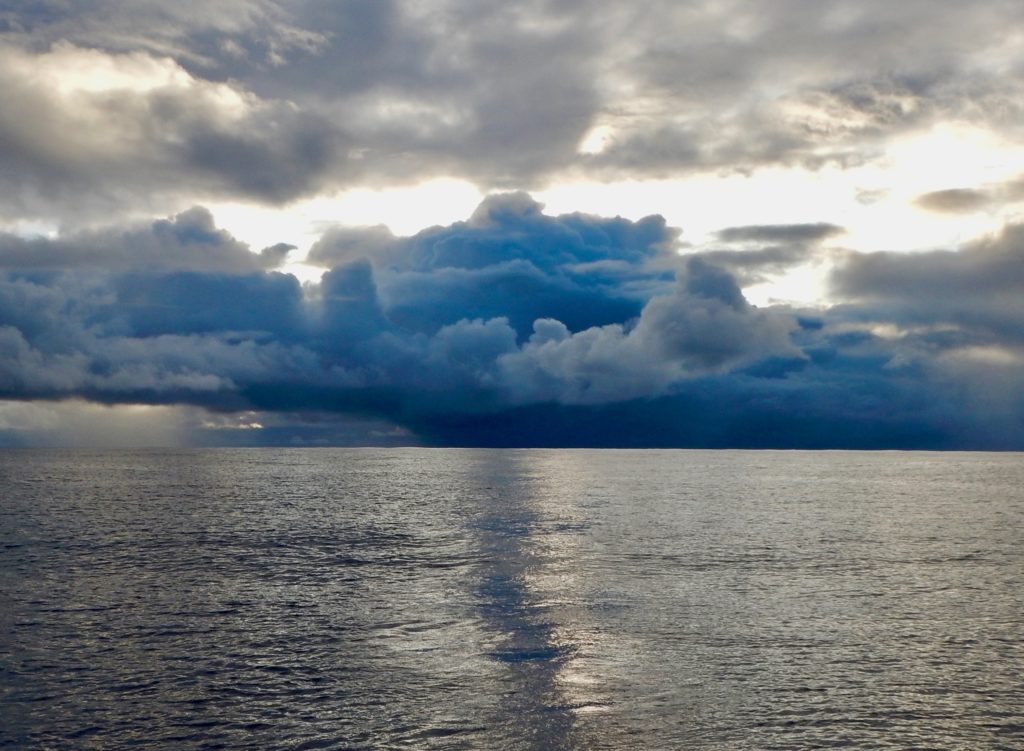
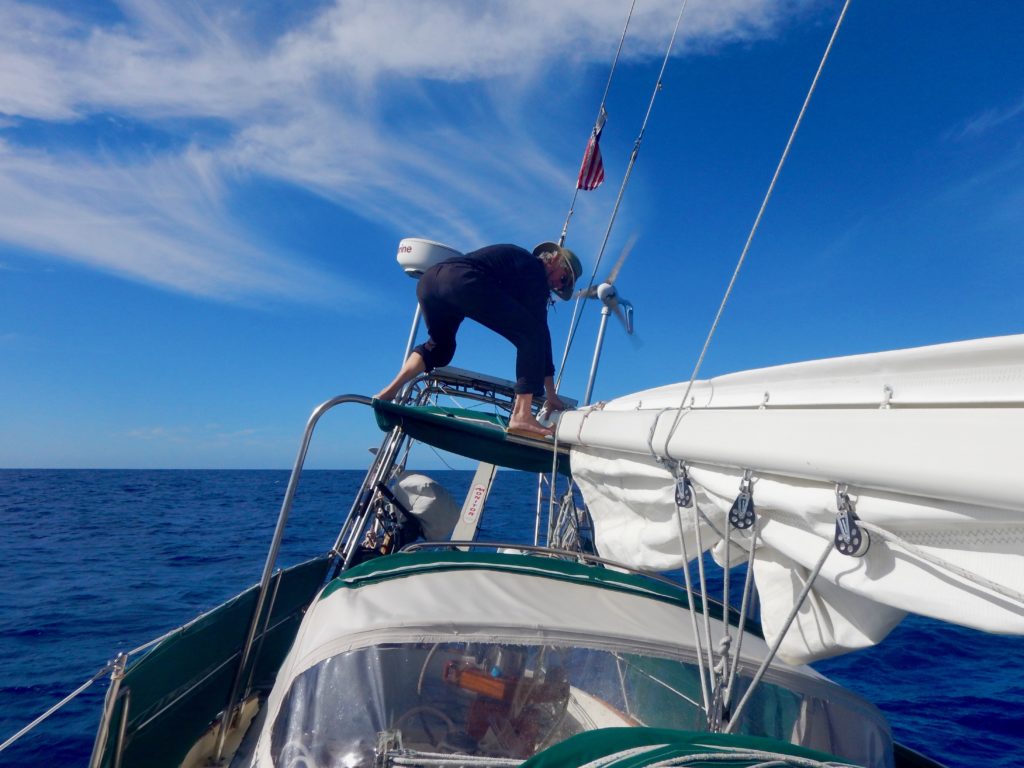
It’s always magic when you make landfall, especially in Hanalei Bay. There is a long fringing beach with coral reefs and surf breaks on either side, lying seemingly in a bowl cut into the bowels of a range of volcanic mountains. There are six waterfalls that are several thousand feet high. The cliffs could never be scaled by anything less than a well disciplined mountain goat. At the shoulders the drop is sheer, and at the knees you will see groves of trees fighting for territory, eucalyptus fighting against Norfolk pine and poinciana. There are fields of taro at the base of the mountains, and these have been cultivated for over a thousand years.
You show up barefooted wearing only swim trunks, and you dress down further from this starting point.
We each made our transitions; Milo flew home, Lindsay set out on a backpacking trip, and I had little more to do than put-put my dinghy each day to the Hanalei River to the spot with two coconut trees to tie to depending on whether it was a spring tide or a neap tide. And right there at Black Pot.
Black Pot Beach is what you see in the opening scene in South Pacific. You would recognize it immediately. It’s a point of land where the Hanalei River meets the bay, a gathering place where the community in old times came together to cook in a giant black iron pot.
Now it was circled off in yellow caution tape. The pier survived the April floods but the sink hole that formed between the pier and claimed five very expensive homes separated Black Pot from the rest of the beach. The Black Pot area would typically be crowded, especially on a holiday or weekend. But now it was cordoned off with signs bearing declarations of trespass. While disconcerting at first, I soon grew accustomed to the yellow tape and became to appreciate that there was a strip of Hanalei that was sealed off, with a hidden entrance just for me. My own private beach, at the mouth of the river where I tied my dinghy every day for two months.
There was a big sink hole, like an inland pond, and at high tide the waves alongside the pier washed into a basin. You could traverse along the beach and duck under the pier to get to the rest of the beach and make your way into town. I came traipsing into town every afternoon or so, hiking up the beach and looking over my shoulder to appreciate that my boat Pamela was anchored right there in the bay.
I joined the volunteer efforts going on around Hanalei for the flood victims of April 15. I met the Singlehanded Transpac fleet sailing into Hanalei Bay from San Francisco and became an honorary member. For the remainder of the summer I sauntered about in a hang-loose shuffle in three-quarter time. While the tourists seemed amped up, glaring at their restaurant meals and anxious about the next rain squall, I stopped worrying about rain squalls. I became, almost, a local.
With no good reason, yet with a sea bag full of aspirations, I’d done it: sailed once more to the tropics on lovely Pamela. It felt really good. I would stay a while. In time I would sail back home, solo, upwind. But for now, I would be Peter Pan for a season.
